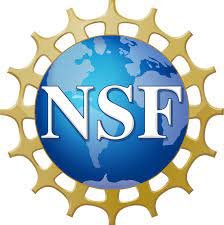Welcome to the Guo lab at the CUNY Advanced Science Research Center
Discovering new ways to generate and detect photons and process their information is at the heart of photonics research. Overcoming the grand challenges of modern photonics — such as realizing affordable chip-scale ultrafast lasers, making more power-efficient and reconfigurable optical nonlinearities, and generating/harnessing photons of vanishingly low energy — requires new materials and clever device architectures, and these technologies stand poised to revolutionize fields like biomedical imaging and sensing, quantum and classical optical computing, and sensing.
The Guo lab employs emerging active photonic platforms to tackle these challenges. We have shown – and hope to continue to show – that the toolbox of dynamic behaviors made available by active photonic materials — nonlinear, laser gain, exciton, hot carrier, and electron-phonon dynamics, among others — allow for the generation and detection of classical and non-classical photons beyond the regimes accessible to conventional laser sources and detectors, as well as for ultrafast information processing. We seek to uncover new physical principles underlying the interaction between light and emerging active photonic materials, and to harness the resulting unprecedented optoelectronic properties in a scalable way to tackle the grand challenges in classical and quantum information processing, optical computing, and sensing.
Research highlights
Latest News
Electrically pumped hyperbolic phonon polaritons Phonon-polaritons are electromagnetic waves resulting from the coherent coupling of photons with optical phonons in polar dielectrics. The conventional approach to exciting phonon-polaritons through optical methods, however, necessitates costly mid-infrared and terahertz coherent light sources along with near-field scanning probes, and generally leads to low excitation efficiency due to the substantial momentum mismatch between phonon-polaritons and free-space photons. Here, we demonstrate that under proper conditions, phonon-polaritons can be excited all-electrically by flowing charge carriers. (arXiv:2310.03926 (2023))
Few-cycle vacuum squeezing in nanophotonics Squeezed quantum states of light are states in which the noise in one of the quadratures is less than the standard quantum noise limit. The generation and manipulation of such states lies at the core of quantum-enhanced technologies, but such systems tend to require auxiliary bulk optical components for their preparation. We demonstrate an integrated nanophotonics platform based on lithium niobate to generate and measure squeezed states on the same optical chip. Such generation and measurement of few-optical-cycle squeezed states in a nanophotonics setting should be useful for the development of scalable quantum information systems. (Science 377, 1333-1337 (2022))
Femtojoule femtosecond all-optical switching Optical nonlinear functions are crucial for various applications in integrated photonics, including all-optical information processing, photonic neural networks and on-chip ultrafast light sources. However, the weak native nonlinearity of most nanophotonic platforms has imposed barriers for such functions by necessitating large driving energies, high-Q cavities or integration with other materials with stronger nonlinearity. Here we effectively utilize the strong and instantaneous quadratic nonlinearity of lithium niobate nanowaveguides for the realization of cavity-free all-optical switching.(Nature Photonics 16, 625–631 (2022))
Efficient electrical detection of graphene plasmons We demonstrate mid-infrared graphene detectors consisting of arrays of plasmonic resonators interconnected by quasi-one-dimensional nanoribbons. Localized barriers associated with disorder in the nanoribbons produce a dramatic temperature dependence of carrier transport, thus enabling the electrical detection of plasmon decay in the nearby graphene resonators. Our device has a subwavelength footprint of 5 × 5 μm2 and operates at 12.2 μm with an external responsivity of 16 mA W–1 and a low noise-equivalent power of 1.3 nW Hz–1/2 at room temperature. (Nature Materials 17, 986-992 (2018))
Jan. 18, 2023 Our group got a $550K National Science Foundation CAREER Award for our research on integrated nonlinear and ultrafast photonics. Thanks to the NSF EPMD program for sponsoring our research! CUNY ASRC News
Dec. 12, 2023 Upcoming invited talks at the Nokia Bell labs, Rensselaer Polytechnic Institute and Stony Brook University
Ultrafast mode-locked laser in nanophotonic lithium niobate Mode-locked lasers are an enabling technology in the ultrafast sciences, providing a platform to generate extremely short pulses of coherent light and precisely spaced frequency combs of light. These lasers are typically bulky, with components sitting on an optical bench. Combining a III-V gain medium with a lithium-niobate nanophotonic chip, we demonstrated the operation of a mode-locked laser with good performance metrics. The results show promise for developing photonic chip–based frequency combs for precision measurements and spectroscopy. (Science 382.6671 (2023): 708-713)
Dec. 10, 2023, Qiushi will be serving as an organizer for the “2D Atomic and Molecular Sheets Beyond Graphene—Optical Properties, Optoelectronics and Quantum Optics” symposium at the MRS 2024 Fall meeting.
Nov. 20, 2023 Qiushi’s interview at ScienceAdvisor
Nov. 10, 2023 Our paper"Ultrafast mode-locked laser in nanophotonic lithium niobate" is published in Science and is selected as the cover story. Also see: Optics and Photonics News, CUNY ASRC News, Caltech News, ScienceAlert, MIT Technology Review (China)
April 13, 2023 Qiushi gave an invited seminar at the University of Southern California. Thanks Prof. Han Wang for the invitation!
Jan. 25, 2023 Qiushi started his appointment as an assistant professor at CUNY Advanced Science Research Center and CUNY Graduate Center Physics Program.
Oct. 24, 2022 Qiushi will be giving an invited talk entitled “Novel graphene mid-infrared photodetectors and emitters: when hot carriers meet 2-D polaritons” at the 2022 MRS Fall Meeting in Boston.
Oct. 10, 2022 Qiushi is selected as 2022 Rising Stars of Light and gave an online icanX talk
Our sponsors












